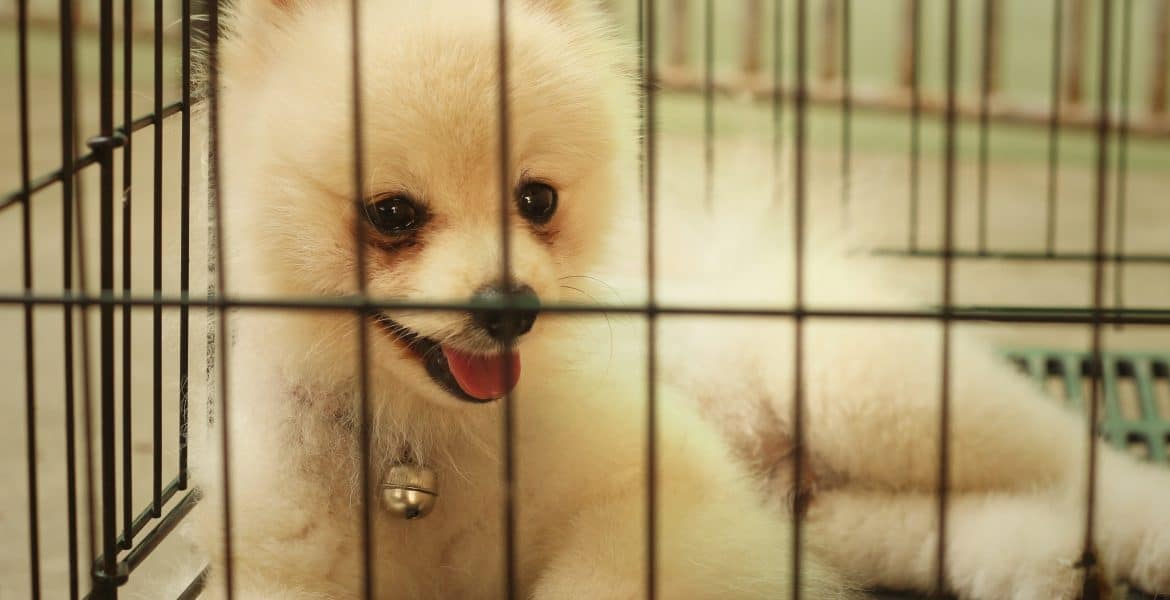How often do you find your dog sleeping under the table, against a wall or behind the settee? Puppies and adult dogs have a natural liking for enclosed sleeping places – and this is where a crate comes in handy.
Dogs like to feel safe and secure when sleeping and have somewhere they can be alone – it goes back to when they survived in the wild – they would seek out a safe den to sleep and rest up. No longer in the wild, a dog crate is able to provide this safe haven. Although their resemblance to cages or prison puts many people off, don’t be fooled! If they are properly used and introduced, they can be a helpful aid to training and toilet training, and a comforting place for when your dog is feeling stressed or tired.
Why use a crate?
- A crate is a safe, secure area for your pup to be, when you can’t give him your full attention
- It can help speed-up house training
- Its somewhere for your puppy to go when he needs time out
- It’s a secure den for your puppy to retreat to, safe in the knowledge that he can relax and won’t be disturbed – You should ensure children and other pets leave puppy alone when he is in it.
- It’s the perfect way to protect your house from damage (especially if you own a puppy and they are not out of the chewing stage!)
- A crate is a safe and secure way to transport your pup and keep your car clean!
- Ideal to use for those breaks away, as its a familiar bed for your dog
How to introduce a crate
Be warned – a dog which is thrust unprepared into a crate and left, is going to associate the crate with an unpleasant experience, and be very unhappy about using them in the future. However a dog which is carefully introduced to a crate usually finds it a pleasant and secure place to be, so it is worth spending some time over the introduction process.
The crate should be big enough for your dog to stand up in, turn round and stretch out when lying down.
Cover the crate with a blanket or sheet so it is dark, den like and cosy.
Initially leave the crate door open so your puppy is free to come and go, use tasty food treats to encourage him – start with them near the door and gradually move them further back once he is happy entering. You can introduce a word like “bed” at this stage, so that he can begin to associate the word with the action!
Feed the dog in the crate every day with the door open and always have a toy or treat in there too. This is an easy way to get him to like it. You shouldn’t close the door overnight until he’s about 12 weeks old, as there’s a chance he might become distressed and won’t be able to control his bowel or bladder until this age.
Invest in a playpen which will allow the puppy to be safe and secure, and still be able to toilet overnight during this training period.
Soon your dog should happily use the crate voluntarily – if he’s not happy to voluntarily go in the crate, don’t force him, that will set up bad associations. Take your time showing him that it is a safe and fun place.
When you do reach the stage where he’s using the crate voluntarily, wait until he goes in for a sleep, then close the door. Stay in the room, and let him out as he starts to wake up.
When your dog is used to this routine, leave him for a minute after he wakes up, (with you still in the room). Gradually (over about a week) increase the time you can do this.
When you can leave the dog with the door closed for a few minutes, leave the room for a short time but stay in the house. Again, gradually increase the time you are out of sight until you can put the dog into his crate when you go out for an hour or two.
Plan to use the crate until the puppy is ten or twelve months old, so he is well past the chewing stage. You won’t have to continue crating once your dog becomes an adult and can be trusted, but your dog will probably enjoy it that much that they’ll use the crate as their own special place! And remember your dog should never be left in a crate for more than a couple of hours, except overnight.
Crates are not just for puppies, they are also a valuable tool to help solve behavioural problems in adult dogs. However crate training older dogs is a lot harder and will require more patience (that’s not to say it’s not possible though!) Good luck!


